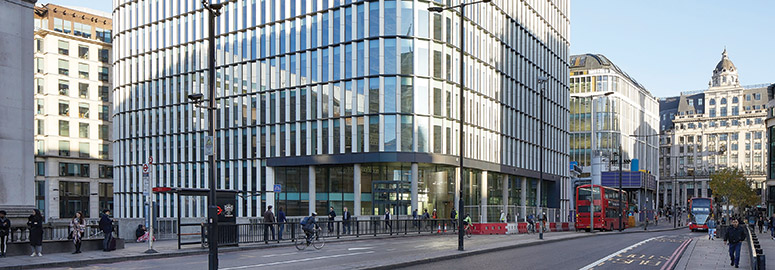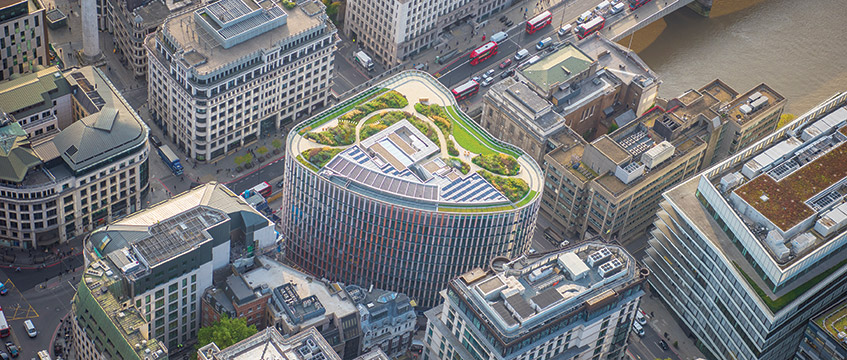Wells Fargo may have commissioned a life-size replica of its iconic logo (a red and gold stagecoach) for the lobby of its new London headquarters at 33 Central, EC4, but there won’t be much else about the office building that reads “traditional bank”.
The world’s second-largest bank by market capitalisation is hoping to make its new 225,000 sq ft office building by London Bridge an exemplar of forward-thinking working practices for its global real estate portfolio of more than 90m sq ft.
“We need to move with the times and have a building, an office environment, that really helps us to recruit and retain talent,” says David Cooper, vice-president, corporate properties, at Wells Fargo, citing Facebook, Google and Amazon’s more employee-friendly workplace environments.
The bank acquired the 11-storey office building on King William Street from developer HB Reavis for £300m in July 2016 as part of a plan to consolidate its four London offices into one location. The move, scheduled for the end of 2018, will see 850 staff move from a combined 89,528 sq ft across Plantation Place, EC3, One America Square, EC3, 90 Long Acre, WC2, and 34 Grosvenor Street, W1.
Take-up at its new office will total 179,568 sq ft after it subleases two floors totalling 45,488 sq ft. HB Reavis is taking the seventh floor on a five-year lease (with some extension options) for its new London headquarters. JLL and Cushman & Wakefield have been instructed to market the sixth floor.
What’s new?
Architecture and design firm Perkins+Will is designing the fit-out, which it is hoped will raise the bar for the bank’s “workplace programme” – its global standard for offices, which it says is about “creating an exciting environment” for its “team members”.
Features of the programme include having wide-open spaces with lots of desks close to windows and internal offices on the inside core. The buildings must follow BREAAM and LED certification guidelines.
The IT system is designed to accommodate fully agile working. “It’s something that we don’t necessarily do very much right now, and it’s something that we are looking to do in the future,” says Cooper.
The greater flexibility ties in with the bank’s strategy to reduce the size of its global real estate portfolio through more efficient use of space, although specific space-saving targets have not been revealed.
While the top floors of banking offices have traditionally been reserved for executives, under the new strategy the best space will be communal, including a landscaped roof garden. The next two floors will be the “One Wells Fargo” connections centre, with meeting areas and a cafeteria.
“We have been doing this for several years now in the US. This will be our first big thrust at it outside the US in London and it’s going to be the very best we have,” says Dave Nelson, the senior vice-president with Wells Fargo’s corporate properties group, who oversees the bank’s international real estate portfolio. The building also includes abundant cycling facilities and 222 showers.
War for talent

The new office design is integral to the bank’s recruitment goals.
“There is a very clear war for talent out there,” says Cooper. “In the good old days you would go and work for a bank or a firm of solicitors or something like that. Nowadays, with the tech market being out there, graduates have got choices in terms of where they go.”
He adds: “There are only certain ways that you can do a trade floor. You can’t have beanbags on the floor and that kind of thing like a Google. But generally I think we are very much trying to bring flexibility and agility to the way our people work.”
Putting employees at the heart of design is central to HB Reavis’s strategy. Radim Rimanek, board director at HB Reavis Group, says: “HB Reavis sees it as being the job of the developer to help companies like Wells Fargo attract that talent. So we don’t look at providing a generic square foot of concrete somewhere.
“We’re really investing massively in terms of people and money into thinking: what will be the right building to make people want to work there? The building that’s going to make them healthier here, that’s going to make them more productive – and in the end that’s going to make them want to stay in that building irrespective of who they are or who they work for.
“It’s not about golden door handles – nobody cares about that. It’s about having things that people really care about – the journeys through the building, the quality of the air and water.”
Brexit threat?
The acquisition of the building, announced a month after the UK voted to leave the European Union, made Wells Fargo the inadvertent poster child for confidence in the City of London’s financial services sector after Brexit. Is the bank comfortable with that label? “I think the deal certainly helped to demonstrate our commitment to the UK,” says Cooper. “It is one of our most important – if not our most important – individual market within EMEA. The timing was interesting, I have to say, but I think as far as we are concerned this was the right thing to do.”
Nelson adds: “We went into this with the knowledge that Brexit was on the horizon, and the idea was we wanted to be where our multinational companies from the US were doing business with us, and London was the centre of that.”
London’s stature is expected to hold up. However, the bank will have to review its operations, depending on what is agreed with regards to the UK’s access to the single market.
“I do not think that a lot of jobs have been lost from the financial sector into other parts of EMEA to date,” says Nelson. “We will have to see what happens. I wish that there was more certainty, but we are definitely looking at that and trying to respond correctly.”
Wells Fargo’s largest European office after London is in Dublin, followed by Paris and Frankfurt. The next priority office for refurbishment, however, will be in New York, where it has leased 500,000 sq ft at Related Companies and Oxford Properties Group’s 30 Hudson Yards.
The 33 Central property is the only one of the bank’s offices that it owns freehold. Would it consider a sale-and-leaseback? “That is not on the table at this point,” says Nelson. “This is the one where we put the stake in the ground, and we wanted it to be perfect.”
Main image: © Jason Hawkes
To send feedback, e-mail Louisa.Clarence-Smith@egi.co.uk or tweet @LouisaClarence or @estatesgazette











